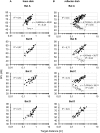Reduction of emission level in approach signals of greater mouse-eared bats (Myotis myotis): No evidence for a closed loop control system for intensity compensation
- PMID: 29543882
- PMCID: PMC5854437
- DOI: 10.1371/journal.pone.0194600
Reduction of emission level in approach signals of greater mouse-eared bats (Myotis myotis): No evidence for a closed loop control system for intensity compensation
Abstract
Bats lower the emission SPL when approaching a target. The SPL reduction has been explained by intensity compensation which implies that bats adjust the emission SPL to perceive the retuning echoes at the same level. For a better understanding of this control mechanism we recorded the echolocation signals of four Myotis myotis with an onboard microphone when foraging in the passive mode for rustling mealworms offered in two feeding dishes with different target strength, and determined the reduction rate for the emission SPL and the increase rate for the SPL of the returning echoes. When approaching the dish with higher target strength bats started the reduction of the emission SPL at a larger reaction distance (1.05 ± 0.21 m) and approached it with a lower reduction rate of 7.2 dB/halving of distance (hd), thus producing a change of echo rate at the ears of + 4 dB/hd. At the weaker target reaction distance was shorter (0.71 ± 0.24 m) and the reduction rate (9.1 dB/hd) was higher, producing a change of echo rate of-1.2 dB/hd. Independent of dish type, bats lowered the emission SPL by about 26 dB on average. In one bat where the echo SPL from both targets could be measured, the reduction of emission SPL was triggered when the echo SPL surpassed a similar threshold value around 41-42 dB. Echo SPL was not adjusted at a constant value indicating that Myotis myotis and most likely all other bats do not use a closed loop system for intensity compensation when approaching a target of interest. We propose that bats lower the emission SPL to adjust the SPL of the perceived pulse-echo-pairs to the optimal auditory range for the processing of range information and hypothesize that bats use flow field information not only to control the reduction of the approach speed to the target but also to control the reduction of emission SPL.
Conflict of interest statement
Figures





Similar articles
-
Intensity control during target approach in echolocating bats; stereotypical sensori-motor behaviour in Daubenton's bats, Myotis daubentonii.J Exp Biol. 2002 Sep;205(Pt 18):2865-74. doi: 10.1242/jeb.205.18.2865. J Exp Biol. 2002. PMID: 12177150
-
Echo-intensity compensation in echolocating bats (Pipistrellus abramus) during flight measured by a telemetry microphone.J Acoust Soc Am. 2007 Mar;121(3):1749-57. doi: 10.1121/1.2431337. J Acoust Soc Am. 2007. PMID: 17407911
-
Different auditory feedback control for echolocation and communication in horseshoe bats.PLoS One. 2013 Apr 24;8(4):e62710. doi: 10.1371/journal.pone.0062710. Print 2013. PLoS One. 2013. PMID: 23638137 Free PMC article.
-
Auditory communication processing in bats: What we know and where to go.Behav Neurosci. 2019 Jun;133(3):305-319. doi: 10.1037/bne0000308. Epub 2019 May 2. Behav Neurosci. 2019. PMID: 31045392 Review.
-
Adaptations for Substrate Gleaning in Bats: The Pallid Bat as a Case Study.Brain Behav Evol. 2018;91(2):97-108. doi: 10.1159/000488873. Epub 2018 Jun 6. Brain Behav Evol. 2018. PMID: 29874652 Review.
Cited by
-
Hunting bats adjust their echolocation to receive weak prey echoes for clutter reduction.Sci Adv. 2021 Mar 3;7(10):eabf1367. doi: 10.1126/sciadv.abf1367. Print 2021 Mar. Sci Adv. 2021. PMID: 33658207 Free PMC article.
References
-
- Griffin DR. Listening in the Dark. 1st ed New Haven: Yale University Press; 1958.
-
- Schnitzler HU, Kalko EKV. Echolocation by Insect-Eating Bats. BioScience 2001;51(7): 557–569.
-
- Schnitzler HU, Moss CF, Denzinger A. From spatial orientation to food acquisition in echolocating bats. Trends Ecol Evol 2003;18(8): 386–394.
-
- Kalko E, Schnitzler HU. How echolocating bats approach and acquire food In: Kunz TH, Racey PA, editors. Bats: phylogeny, morphology, echolocation, and conservation biology. Washington, DC: Smithsonian Institution Press; 1998. pp. 197–204.
-
- Berkowitz A, Suga N. Neural mechanisms of ranging are different in two species of bats. Hear Res 1989;41(2–3): 255–264. - PubMed
Publication types
MeSH terms
LinkOut - more resources
Full Text Sources
Other Literature Sources
Miscellaneous

